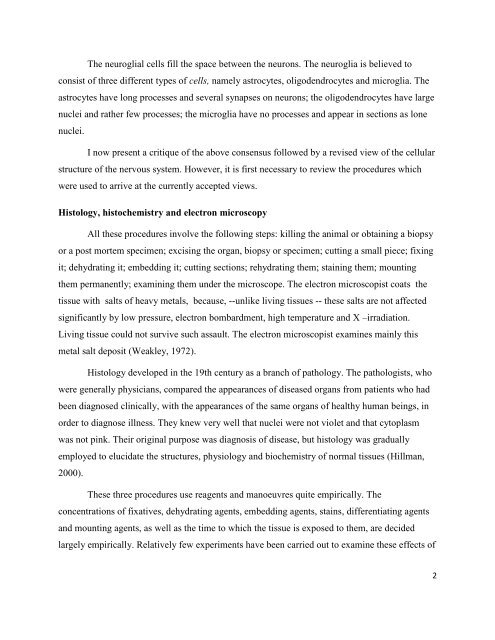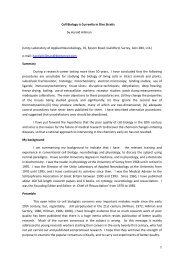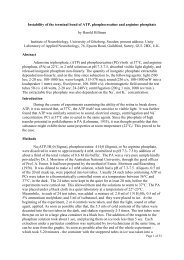download PDF version - Dr Harold Hillman
download PDF version - Dr Harold Hillman
download PDF version - Dr Harold Hillman
- No tags were found...
Create successful ePaper yourself
Turn your PDF publications into a flip-book with our unique Google optimized e-Paper software.
The neuroglial cells fill the space between the neurons. The neuroglia is believed toconsist of three different types of cells, namely astrocytes, oligodendrocytes and microglia. Theastrocytes have long processes and several synapses on neurons; the oligodendrocytes have largenuclei and rather few processes; the microglia have no processes and appear in sections as lonenuclei.I now present a critique of the above consensus followed by a revised view of the cellularstructure of the nervous system. However, it is first necessary to review the procedures whichwere used to arrive at the currently accepted views.Histology, histochemistry and electron microscopyAll these procedures involve the following steps: killing the animal or obtaining a biopsyor a post mortem specimen; excising the organ, biopsy or specimen; cutting a small piece; fixingit; dehydrating it; embedding it; cutting sections; rehydrating them; staining them; mountingthem permanently; examining them under the microscope. The electron microscopist coats thetissue with salts of heavy metals, because, --unlike living tissues -- these salts are not affectedsignificantly by low pressure, electron bombardment, high temperature and X –irradiation.Living tissue could not survive such assault. The electron microscopist examines mainly thismetal salt deposit (Weakley, 1972).Histology developed in the 19th century as a branch of pathology. The pathologists, whowere generally physicians, compared the appearances of diseased organs from patients who hadbeen diagnosed clinically, with the appearances of the same organs of healthy human beings, inorder to diagnose illness. They knew very well that nuclei were not violet and that cytoplasmwas not pink. Their original purpose was diagnosis of disease, but histology was graduallyemployed to elucidate the structures, physiology and biochemistry of normal tissues (<strong>Hillman</strong>,2000).These three procedures use reagents and manoeuvres quite empirically. Theconcentrations of fixatives, dehydrating agents, embedding agents, stains, differentiating agentsand mounting agents, as well as the time to which the tissue is exposed to them, are decidedlargely empirically. Relatively few experiments have been carried out to examine these effects of2




